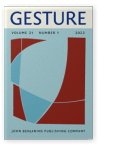Vol. 21:1 (2022) ► pp.1–27
Indexing turn-beginnings in Norwegian Sign Language conversation
It is well known that signers and speakers routinely produce finger points during interaction. While the referential functions of such finger points have received great attention from researchers, they are also used to manage interactions between interlocutors. These functions are less understood and have received less research focus. The current study helps to redress this gap in the literature by investigating how finger pointing is used to index and coordinate turn-beginnings in a corpus of 11 semi-naturalistic (Norwegian) signed language conversations, involving between two to five signers (3.4 hours of signing). The data was initially annotated in ELAN and then further qualitative analysis was conducted. This investigation revealed that finger pointing effectively indexes previous and upcoming discourse, thereby binding sequences of conversational moves and guiding their trajectory, helping signers to coordinate turn transitions and interaction as it unfolds.
Article outline
- Coordinating and collaborating in multimodal conversation
- Finger points as symbolic indexicals
- Multimodal turn-beginnings in spoken and signed languages
- Turn-beginnings, pre-beginnings, and presegments
- Eye gaze, pointing, and other bodily actions during turn-beginnings
- Data and analysis for the current study
- Designing turn-beginnings and indexing meanings across moves in Norwegian Sign Language conversations with finger pointing
- Responding to a question
- Responding to a comment by an interlocutor
- Pointing to coordinate turn trajectory and to collaborate on a joint word search
- Discussion
- Conclusion
- Acknowledgements
- Notes
- Abbreviations
-
References
